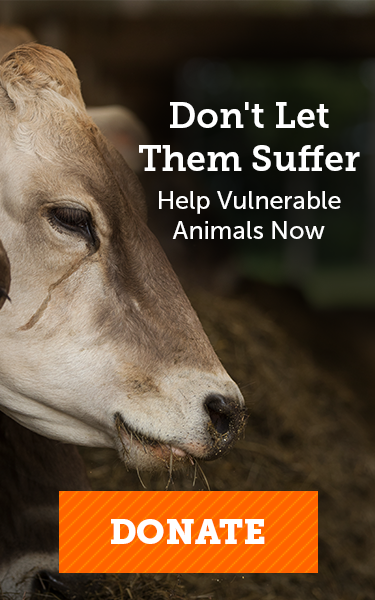
Confinement, Outdoor Access, Space & Enrichment
How Animals Are Housed
Close confinement, Indoor space & Enrichment
Battery cages (laying hens), gestation and farrowing crates (pregnant and mother pigs), veal crates (dairy calves), and tie stalls (female dairy cows) are the most restrictive forms of close confinement used to house farm animals. High stocking densities (e.g., for broiler chickens and turkeys, as well as pigs, cattle and laying hens in some cage-free environments [1] ) also severely limit free movement of farm animals. The ASPCA opposes all forms of severe confinement and advocates for housing that at least gives animals freedom of movement such that they can stand up, lie down, turn around, and stretch their limbs. Alternatives to close confinement exist, and the ASPCA encourages the transition and upgrade to these more humane housing systems, which should be combined with proper husbandry and management.
In addition to adequate space, a critical aspect to housing is access to materials/enrichment to allow animals to engage in the basic natural behaviors instinctive to their species (such as foraging, rooting, dust-bathing, perching, nest-building). Animals should have comfortable resting areas with ready access to food and water. The housing of animals is interconnected to several of the Five Freedoms particularly Freedom from Fear and Distress , Freedom from Discomfort , and Freedom to Express Normal Behavior .
Outdoor Access
The ASPCA believes farm animals should be given sufficient time in an outdoor environment, where weather conditions permit, that provides them with adequate space, vegetation or environmental enrichment, natural light, fresh air, and protection from deleterious weather conditions, predators and disease. Animals should also be fit enough to use outdoor space through choice of healthy breeds and/or genetically selecting breeding stock for robust traits. This is a particular concern for modern breeds of “broiler” chickens and turkeys that have compromised immunity, mobility and cardiovascular health. The conditions and amount of time outdoors must be tailored to the animals’ species, breed and region. When animals are kept indoors for long periods of time, they should be provided with as outdoor-like an experience as possible: enrichment of their living environment, natural light, fresh air, sufficient space, and the ability to engage in natural behaviors. These issues are important for providing animals with Freedom to Express Normal Behavior.
Feedlots for Beef Cattle
The ASPCA opposes the use of feedlots to house and fatten cattle in the months prior to slaughter. Feedlots expose cattle to adverse weather elements, deprive them of pasture and forage, force them to eat foods that stress their digestive systems, mix unfamiliar cattle together, and add an additional transport event. Cattle should be kept on pasture with sufficient space to graze comfortably and protection from the elements throughout their lives, where climate permits. Where climate does not permit year-round pasture, cattle in any housing environment should be provided with forage, rather than grain, throughout their lives. Until feedlots are phased out, cattle in feedlots should have sufficient protection from wind, heat and cold, including shade and shelters, and should have raised, dry areas on which to stand and lie.
[1]
National Chicken Council welfare guidelines allow 8.5 lbs per square foot for 5.6 to 7.5 lb birds
http://www.nationalchickencouncil.org/wp-content/uploads/2015/08/NCC-Guidelines-Broilers-August2015.pdf
United Egg Producer welfare guidelines allow for 1 sq foot per hen
http://uepcertified.com/wp-content/uploads/2015/08/2016-UEP-Animal-Welfare-Guidelines-2016-Cage-Free-Edit-002.pdf
National Hog Farmer cites that farmers plan for 3 sq ft per growing pig
http://www.nationalhogfarmer.com/mag/farming_housing_decisions_growing
